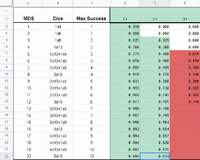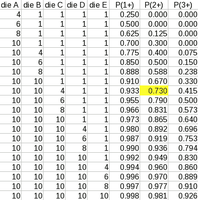Hello,
I'm looking for assistance in devising an equation to determine the probability of outcomes on dice pools. I'm having two issues in doing it myself, because I'm not looking for the probability of the sums of the dice, but the likelihood that each group of dice will have dice that roll equal to or greater than a given threshold (4 or 8). These thresholds represent "success". Greater than 4 is 1 success. Greater than 8 is 2 successes. The dice we use are d4, d6, d8, and/or d10.
The system scales the dice. We start with 1d4, move up to 1d6, then 1d8, and 1d10. After this, we add a second die that scales. So: 1d10 & 1d4, 1d10 & 1d6, etc. The same thing happens after 2d10, all the way up to 5d10.
So, for example, in 1d10&1d4, the chance of one of them rolling => 4 (1 success) is 77.50% (70% for the 1d10 to land 4-10, 7.5% chance for the 1d4 to land 4 and the 1d10 to land 1-3) if I've done my math right. The chance of 2 successes (1d10 >= 8 OR 1d10 = {4..7} & 1d10 = 4) is 30%. I think.
It's been slow going, but I'm hoping to speed up the process.
I'm looking for assistance in devising an equation to determine the probability of outcomes on dice pools. I'm having two issues in doing it myself, because I'm not looking for the probability of the sums of the dice, but the likelihood that each group of dice will have dice that roll equal to or greater than a given threshold (4 or 8). These thresholds represent "success". Greater than 4 is 1 success. Greater than 8 is 2 successes. The dice we use are d4, d6, d8, and/or d10.
The system scales the dice. We start with 1d4, move up to 1d6, then 1d8, and 1d10. After this, we add a second die that scales. So: 1d10 & 1d4, 1d10 & 1d6, etc. The same thing happens after 2d10, all the way up to 5d10.
So, for example, in 1d10&1d4, the chance of one of them rolling => 4 (1 success) is 77.50% (70% for the 1d10 to land 4-10, 7.5% chance for the 1d4 to land 4 and the 1d10 to land 1-3) if I've done my math right. The chance of 2 successes (1d10 >= 8 OR 1d10 = {4..7} & 1d10 = 4) is 30%. I think.
It's been slow going, but I'm hoping to speed up the process.



